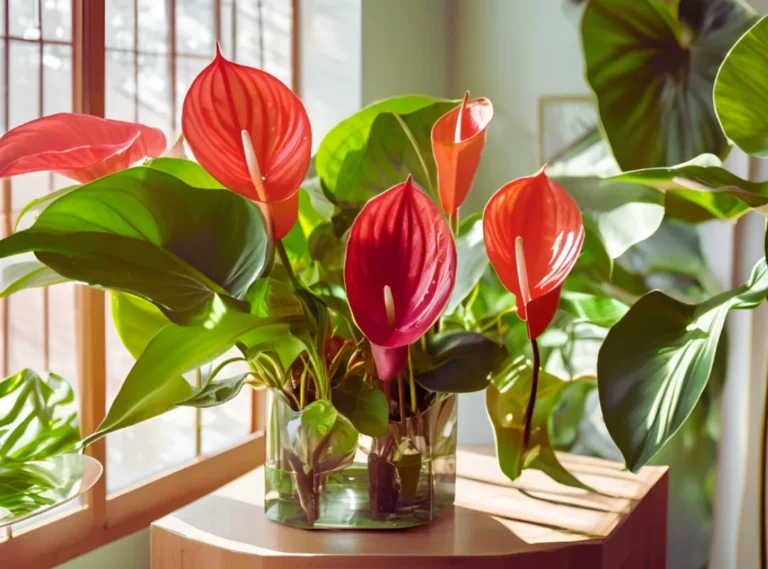When it comes to striking houseplants, Anthurium pallidiflorum stands out like no other. With its captivating, velvety leaves and tropical charm, it has earned a spot in the hearts of plant enthusiasts worldwide. Whether you’re a seasoned collector or just dipping your toes into the lush world of aroids, this guide will help you understand everything there is to know about this rare beauty.
Understanding Anthurium Pallidiflorum
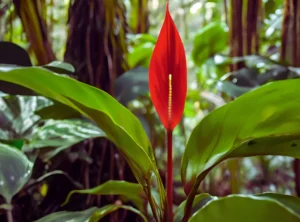
Origins and Natural Habitat
Native to the rainforests of Ecuador, Anthurium pallidiflorum thrives in humid, shaded environments. These tropical havens, with their consistently warm temperatures and high humidity levels, are the perfect backdrop for the plant’s growth. The rainforest canopy offers dappled sunlight, mimicking the ideal indoor conditions you’ll want to replicate at home.
Interestingly, this plant grows as an epiphyte, attaching itself to trees and drawing nutrients from the air, rain, and surrounding organic debris. This unique adaptation contributes to its mystique and explains some of its specific care needs.
Distinctive Features of Anthurium Pallidiflorum
The hallmark of this plant is undoubtedly its long, narrow leaves with a velvety texture that seems to shimmer under the right light. Unlike other anthuriums, pallidiflorum leaves lack the heart shape that’s often associated with the genus, favoring an elongated, strap-like form instead. This unique foliage is not just visually stunning—it’s a tactile experience that makes the plant even more special.
Moreover, its deep green hue contrasts beautifully with its pale, pronounced veins, creating a visual effect that feels almost otherworldly.
Importance of Anthurium Pallidiflorum in Horticulture
Why It’s Considered Rare
The rarity of Anthurium pallidiflorum isn’t just about its native habitat. Its scarcity is also tied to its specific growth conditions and slower propagation rate. It’s not a plant you’ll commonly stumble upon in big-box garden centers, which only adds to its appeal among collectors.
Demand Among Collectors and Enthusiasts
Collectors are always on the lookout for plants that bring uniqueness to their collections, and Anthurium pallidiflorum delivers in spades. Its distinctive aesthetic and the challenge of growing it make it highly desirable. Add in the fact that it often fetches a premium price, and you’ve got a true plant-world star.
Who Should Consider Growing Anthurium Pallidiflorum?
Ideal for Indoor Gardeners and Aroid Enthusiasts
If you’re someone who loves a challenge and has a knack for nurturing tropical plants, this one’s for you. While it might demand a little extra care, the payoff is worth every effort. Plus, if you’re already a fan of aroids, the addition of pallidiflorum to your collection is sure to elevate your plant-parenting cred.
Suitability for Different Climate Zones
While it thrives in warmer, humid environments, this plant can adapt to various conditions if you’re willing to make adjustments. For instance, those in drier climates might need to rely on humidifiers or pebble trays to replicate the plant’s natural surroundings. The key is consistency—maintaining steady warmth and humidity ensures the plant’s happiness.
Common Misconceptions About Anthurium Pallidiflorum
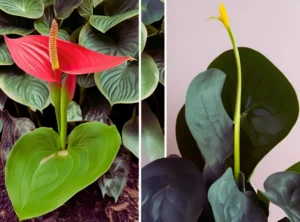
Confusion with Similar Species
At first glance, Anthurium pallidiflorum might be mistaken for other narrow-leafed anthuriums, such as vittarifolium or warocqueanum. However, the velvety texture of its leaves and its distinct growth habits set it apart. For collectors, spotting these subtle differences becomes a delightful challenge.
Care Requirements: Easy or Challenging?
Some might label pallidiflorum as a “high-maintenance” plant, but the truth lies somewhere in the middle. Yes, it has specific needs, but once you understand its natural habitat and replicate those conditions, it’s relatively straightforward to care for. Think of it as a plant that demands attention but rewards you generously for it.
Characteristics of Anthurium Pallidiflorum
Description of Leaves, Growth Habit, and Structure
The Anthurium pallidiflorum is a true showstopper in the world of plants, thanks largely to its leaves. These long, strap-like leaves can grow up to several feet in length, making them a statement piece in any collection. The velvety texture is not just aesthetically pleasing but also functional, as it helps the plant retain moisture. Additionally, the plant’s pale veins stand out against its deep green backdrop, creating a striking visual effect.
This anthurium exhibits a rosette growth habit, with new leaves unfurling gracefully from the center. Unlike bushy plants, it maintains a streamlined silhouette, which adds to its elegance. Moreover, the plant grows relatively slowly, which is typical of many rare aroids. This slow growth means it requires patience, but it also makes each new leaf feel like a mini celebration.
Differences Between Anthurium Pallidiflorum and Vittarifolium
A common point of confusion among collectors is distinguishing pallidiflorum from its close relative, vittarifolium. While both plants share elongated leaves, the differences are clear when you look closely. Pallidiflorum boasts a soft, velvety texture, while vittarifolium has a smoother, almost leathery feel. Additionally, vittarifolium often has a more pronounced trailing growth habit, making it a popular choice for hanging displays.
These subtle yet significant differences highlight why understanding your plant’s characteristics is so important. Knowing exactly what you have can help you tailor its care and showcase its unique features.
Growth Cycle and Seasonal Behavior
One of the fascinating aspects of Anthurium pallidiflorum is its growth cycle. It tends to produce new leaves during the warmer months, when light and humidity levels are optimal. Conversely, during cooler seasons, its growth may slow significantly, almost as if the plant is taking a well-deserved break.
Understanding this natural rhythm is crucial for proper care. For example, fertilizing during its active growth period can encourage larger, healthier leaves. On the other hand, reducing watering during dormancy helps prevent overwatering—a common pitfall for many plant parents.
Care Requirements for Anthurium Pallidiflorum
Ideal Lighting Conditions
Like many tropical plants, Anthurium pallidiflorum thrives in bright, indirect light. Direct sunlight can scorch its delicate leaves, while low light can lead to slower growth and smaller foliage. A spot near an east-facing window is often ideal, as it provides gentle morning light without the harsh afternoon rays.
If you don’t have access to natural light, don’t worry—this plant adapts well to artificial grow lights. Just ensure the light source is positioned appropriately to mimic the dappled sunlight it would receive in its natural habitat.
Optimal Temperature and Humidity Levels
Temperature and humidity are two key factors that can make or break your pallidiflorum’s success. Ideally, the plant prefers temperatures between 65°F and 80°F, which closely mimic its native rainforest environment. Sudden temperature drops or drafts can stress the plant, so it’s important to place it in a stable location.
When it comes to humidity, aim for levels above 60%. If your home tends to be on the drier side, using a humidifier or grouping plants together can help maintain a more humid microclimate. Another option is to place the pot on a pebble tray filled with water, which adds moisture to the air as it evaporates.
Importance of Consistent Moisture
Keeping the soil evenly moist is critical for Anthurium pallidiflorum. However, it’s a fine balance—too much water can lead to root rot, while too little can cause the plant to dry out and develop crispy leaf edges. Watering once the top inch of soil feels dry is a good rule of thumb, though the frequency may vary depending on factors like temperature and humidity.
Using lukewarm, filtered water can further reduce the risk of shocking the plant, especially if your tap water contains high levels of minerals or chlorine.
Fertilizing Tips for Healthy Growth
To support its growth, pallidiflorum benefits from regular fertilization during the growing season. A balanced, water-soluble fertilizer diluted to half strength works well. Fertilizing once a month from spring through early fall is sufficient to provide the nutrients it needs.
It’s important to avoid over-fertilizing, as this can cause salt buildup in the soil and damage the roots. Flushing the soil with clean water every few months can help prevent this issue and keep your plant thriving.
Choosing the Best Substrate for Anthurium Pallidiflorum
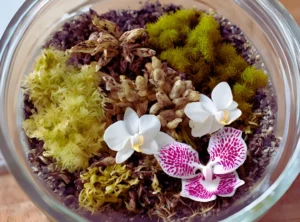
Characteristics of the Ideal Substrate
Given its epiphytic nature, Anthurium pallidiflorum requires a well-draining substrate that allows air to circulate around its roots. Heavy, compacted soils can suffocate the plant, leading to poor growth or even root rot.
Well-Draining and Aerated Mixtures
The ideal mix should combine drainage, aeration, and moisture retention. Ingredients like bark, perlite, and sphagnum moss work beautifully together to achieve this balance. Bark provides structure and drainage, while perlite ensures aeration. Meanwhile, sphagnum moss holds onto just enough moisture to keep the roots hydrated without waterlogging them.
Recommended Ingredients: Bark, Perlite, Sphagnum Moss
A simple yet effective substrate recipe includes:
- 2 parts orchid bark
- 1 part perlite
- 1 part sphagnum moss
This combination mirrors the plant’s natural growing conditions, providing a supportive environment for its roots.
Maintaining the Substrate Over Time
Over time, organic components like bark and moss break down, reducing aeration and drainage. To keep the substrate fresh, consider repotting your pallidiflorum every 12–18 months. During this process, inspect the roots for signs of rot or damage and trim them as needed.
Challenges and Solutions for Growing Anthurium Pallidiflorum
Common Pests and How to Manage Them
Like many houseplants, pallidiflorum is susceptible to pests such as spider mites, mealybugs, and scale. Regularly inspecting the leaves, especially their undersides, can help catch infestations early.
For minor infestations, wiping the leaves with a mixture of water and mild dish soap can be effective. In more severe cases, using an insecticidal soap or neem oil spray is a reliable solution.
Addressing Overwatering and Root Rot
Overwatering is one of the most common issues with this plant. Symptoms like yellowing leaves and mushy roots often point to root rot. If this occurs, remove the plant from its pot, trim the affected roots, and repot it in fresh, well-draining substrate. Adjust your watering routine to prevent recurrence.
Troubleshooting Slow Growth or Leaf Discoloration
Slow growth or discoloration can result from factors such as insufficient light, improper watering, or nutrient deficiencies. Adjusting these variables—providing brighter light, refining your watering schedule, or fertilizing appropriately—can usually resolve the issue.
How to Propagate Anthurium Pallidiflorum Successfully
Propagation via Division
One of the easiest and most reliable ways to propagate Anthurium pallidiflorum is through division. This method works best when your plant has grown significantly and has multiple growth points or “clumps.” To begin, carefully remove the plant from its pot and gently loosen the soil around the roots.
Next, look for natural separations in the root system where you can divide the plant. Using a clean, sharp knife or pruning shears, cut between the sections, ensuring each piece has both roots and a healthy growth point. Once divided, pot each section into fresh substrate, water lightly, and place them in a warm, humid environment to encourage new growth.
Division not only helps propagate new plants but also revitalizes the parent plant by reducing overcrowding in its pot.
Best Practices for Root Cuttings
Another method of propagation involves taking root cuttings. While this technique is less common, it can be effective if you’re careful. Begin by selecting a healthy root section with visible nodes. Cut a small segment, ensuring it’s free of rot or damage.
Plant the cutting horizontally in a moist substrate mix, such as a combination of sphagnum moss and perlite. Keep the humidity high by covering the pot with a plastic dome or placing it in a greenhouse. Within a few weeks, new growth should emerge, signaling successful propagation.
Displaying Anthurium Pallidiflorum in Your Home
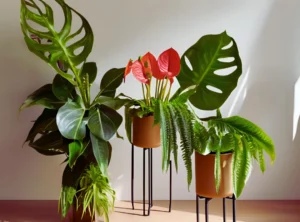
Ideal Pot Choices and Placement
Choosing the right pot is essential for both functionality and aesthetics. For pallidiflorum, opt for a pot with drainage holes to prevent waterlogging. Terracotta pots are a great option because they allow excess moisture to evaporate, but plastic pots can work just as well if you’re diligent about watering.
When it comes to placement, this plant thrives in bright, indirect light. A spot near an east-facing window is often ideal, as it provides gentle morning sun without risking leaf scorch. Additionally, placing the plant on a decorative plant stand or shelf can elevate its striking foliage and make it the focal point of your indoor garden.
Integrating Anthurium Pallidiflorum into Indoor Plant Collections
Anthurium pallidiflorum pairs beautifully with other tropical plants, especially those with contrasting textures or colors. For example, placing it alongside broad-leafed calatheas or colorful philodendrons can create a visually dynamic arrangement.
If you have a collection of aroids, grouping your plants together can help replicate their natural environment, as the combined humidity from multiple plants benefits them all. Just be mindful of spacing to ensure adequate airflow and prevent the spread of pests or disease.
Real-World Examples and Success Stories
Experiences from Aroid Enthusiasts
Plant enthusiasts often rave about the satisfaction of growing pallidiflorum. One collector shared their story of rescuing a neglected plant from a clearance rack and nursing it back to health with proper humidity and lighting. Over time, the plant rewarded them with lush, velvety leaves that became the star of their collection.
Another common theme among growers is the joy of watching the plant’s slow but steady growth. Each new leaf feels like an accomplishment, and the process of learning its care needs fosters a deeper connection with the plant.
Tips From Professional Growers
Professional growers often emphasize the importance of consistency when it comes to pallidiflorum. For example, maintaining stable humidity levels and avoiding sudden environmental changes can make a world of difference. They also recommend using a hygrometer to monitor humidity and investing in a grow light for darker spaces.
Another pro tip is to rotate the plant regularly to ensure even light exposure, which helps prevent uneven growth or leaning. With these small adjustments, even beginner plant parents can achieve success with this rare aroid.
Summary and Future of Anthurium Pallidiflorum
Why It Remains a Coveted Plant
The allure of Anthurium pallidiflorum lies in its unique combination of beauty and rarity. Its velvety, elongated leaves are unlike anything you’ll find in more common houseplants, and its care requirements, while specific, are manageable with a little effort. This plant is not just a decorative addition to your home—it’s a statement of your dedication as a plant enthusiast.
Future Trends in Cultivating Rare Aroids
As interest in aroids continues to grow, so does the demand for rare plants like pallidiflorum. Advances in propagation techniques, such as tissue culture, may make these plants more accessible in the future, but their rarity and allure are unlikely to fade.
Additionally, the rise of online plant communities has created a space for collectors to share tips, trade cuttings, and celebrate their successes. This sense of community ensures that rare plants like pallidiflorum will continue to thrive, both in homes and in horticultural collections.
Resources for Learning More About Anthurium Pallidiflorum
Recommended Books and Guides
- The Complete Guide to Aroids by D.J. White
- Tropical Plants: Care and Cultivation by R. Sanderson
- Houseplant Masterclass: Rare and Exotic Varieties by L. Parker
These books offer detailed insights into the care of rare plants and provide practical tips for both beginners and seasoned collectors.
Online Communities and Forums for Aroid Growers
Joining online forums and social media groups is a great way to connect with other aroid enthusiasts. Platforms like Reddit’s r/houseplants and Facebook groups dedicated to rare plant trading are excellent resources. Additionally, Instagram is a goldmine for inspiration, with countless accounts showcasing breathtaking collections of tropical plants.
FAQs About Anthurium Pallidiflorum
1. Is Anthurium Pallidiflorum rare?
Yes, Anthurium pallidiflorum is considered rare, primarily because of its limited natural habitat and specific care requirements. It originates from the rainforests of Ecuador, where it thrives as an epiphyte. Moreover, its slow growth rate and higher price point contribute to its exclusivity. However, as interest in aroids grows, propagation efforts are making it slightly more accessible to dedicated collectors.
2. What is the best way to care for Anthurium Pallidiflorum?
Caring for pallidiflorum requires creating an environment similar to its native habitat. It thrives in bright, indirect light, warm temperatures (65°F to 80°F), and humidity levels above 60%. Additionally, keeping the soil consistently moist but well-draining is key to preventing overwatering issues. To ensure success, using a substrate mix of orchid bark, perlite, and sphagnum moss is highly recommended.
3. How can I propagate Anthurium Pallidiflorum?
Propagation is best done through division, where you separate sections of the plant that have their own roots and growth points. This method ensures a higher chance of survival for the new plant. Another option is rooting cuttings in moist sphagnum moss under high humidity conditions. Regardless of the method, providing consistent warmth and moisture is crucial for successful propagation.
4. What is the difference between Anthurium Pallidiflorum and Anthurium Vittarifolium?
While both plants share elongated leaves, pallidiflorum stands out with its velvety texture and slightly darker coloration. In contrast, vittarifolium has smoother, more leathery leaves and often grows as a trailing plant, making it popular for hanging displays. These differences, though subtle, are key when identifying or caring for each species.
5. What kind of pot is best for Anthurium Pallidiflorum?
A pot with drainage holes is essential to prevent waterlogging, which can lead to root rot. Terracotta pots are an excellent choice because they promote airflow and help excess moisture evaporate. However, plastic pots work well too, as long as you monitor watering closely. Choosing a size that accommodates the plant’s root system without overcrowding is also important for healthy growth.
6. What pests should I watch out for on Anthurium Pallidiflorum?
Common pests include spider mites, mealybugs, and scale insects. Regularly inspecting the leaves—especially their undersides—can help you catch infestations early. If pests are detected, wiping the leaves with a mixture of water and mild dish soap or using neem oil can effectively manage the problem. Consistent care and proper humidity levels can also reduce the likelihood of pests.
7. Why are the leaves on my Anthurium Pallidiflorum turning yellow?
Yellowing leaves are often a sign of overwatering or improper light exposure. If the plant receives too much water, its roots may begin to rot, causing discoloration. Alternatively, placing the plant in direct sunlight can scorch its leaves, leading to yellow patches. Adjusting your watering schedule and moving the plant to a spot with bright, indirect light can usually resolve the issue.

